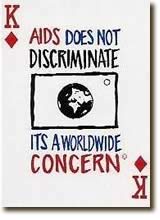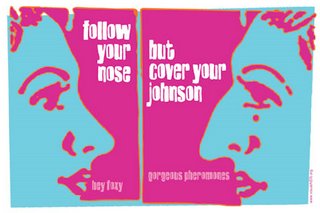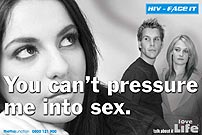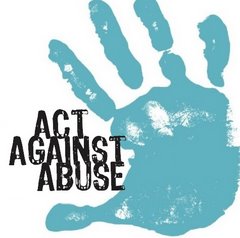Wednesday, November 01, 2006
Introduction to Our Topic
16 Days of Activism -
a) What is the 16 Days of Activism Campaign?
b) When are the 16 Days, and do these dates have any significance?
c) What is it intended to achieve?
d) How can we participate?
UNAIDS theme –
a) What is the theme for this year?
b) What is the link between 16 Days Campaign and UNAIDS? (In addressing this issue we had to determine the link between gender-related violence and HIV/AIDS)
c) How is it significant in South Africa?
d) How do we implement the UNAIDS theme into our campaign?
We will now briefly discuss each of these components and their various issues.
1. 16 Days of Activism –
a) What is the 16 Days of Activism Campaign?
The 16 Days of Activism Against Gender-Violence is a global campaign aimed at creating awareness around gender-violence, advocating for its elimination and assisting women who are victims of gender violence. It seeks to hold governments accountable for the promises they have made.
This year’s national theme is ‘Celebrate 16 years of 16 Days: Advance Human Rights and End Violence Against Women’.[1]
It seeks to reflect and celebrate the achievements the Campaign has made in the past, and to use successes as a source of inspiration for present and future efforts.
The theme continues with the core elements of utilizing human rights as a means of ending gender-based violence and is a means of acknowledging that while great triumphs should be celebrated, the fight is by no means over. There is still much to be done before the right to equality is truly realized and violence against women and children is effectively dealt with.
b) When are the 16 Days, and do these dates have any significance?
Participants in the 16 Days of Activism campaign chose the dates November 25th (International Day for No Violence Against Women) and December 10th (International Human Rights Day) to illustrate symbolically the link between gender-based violence and human rights and to illustrate that violence against women is a gross human rights violation[2].
The campaign includes 1st December, which is World AIDS Day. This brings into the campaign the global issue of HIV/AIDS and compels society to address the link between gender-violence and HIV/AIDS. Included in the campaign are dates of remembrance, such as November 29th which is International Women Human Rights Defenders Day and December 6th, which marks the Anniversary of the Montreal Massacre.[3]
c) What is the campaign intended to achieve?
The 16 Days Campaign has been used as a coordinating strategy by individuals and groups to call for the eradication of all forms of violence against women by:
- To create an increased level of awareness amongst South Africans relating to the frequency and occurrence of violence perpetuate against women and children, how it reveals itself within our society and the negative impact that violence has on these vulnerable groups;
- To challenge perpetrators of these offences to change their behaviour;
- To enhance and broaden partnerships between government, the private sector, civil society, organised labour unions, the faith-based organisations and the media (electronic and print) in an effort to spread the message;
- To align events in the national programme with that of the international theme for this year, which focuses on celebrating 16 years of 16 Days of Activism and advancing human rights to end abuse;
- To raise funds for NGOs that work within the sector, providing important support to the victims and survivors of violence;
- To engage actively with men and boys in relation to combating violence in homes, communities and in the workplace; and
- To highlight the stories of survivors of gender-based violence and the impact that the campaign has had on their lives.[4]
d) How can we participate?
As a group we identified the following ways to participate –
Investigate and explore – research the 16 Days of Activism, it’s related issues in order to find out as much as we can, so that we can effectively plan and implement our various strategies;
Educate and Inform – create awareness about the 16 Days – this is being done by:
- publishing information in community newspapers, online newspapers, forum discussions;
- distributing information packages, flyers and posters, badges, stickers;
- sharing information on our website; and
- participating in the Red and White Ribbon Campaign.
Act and contribute – by assisting organizations that help abused women and children – this is being done by
- Collecting items to assist these organizations (food, clothing, toiletries etc)
- Raising funds for these organisations
Share, participate and commemorate – our findings, reports, pamphlets, posters and various other campaign materials were submitted to the Centre for Women’s Global Leadership[5] to form part of this year’s international campaign, and to be added to the International Archives so that it forms part of the resource pool that can be used for other individuals or organizations in their research and implementation of similar endeavours.
2. UNAIDS theme –
a) What is the theme for this year?
The UNAIDS theme is ‘Stop AIDS. Keep the Promise’, this is in relation to the promises that government has made in order to combat the AIDS pandemic. It focuses on government accountability.
In relation to individuals, the theme is ‘Stop Aids. Make the Promise’[6]. This involves making the pledge to know one’s status, practice safer sex and thus assisting in halting the spread of HIV/AIDS.
b) What is the link between 16 Days Campaign and UNAIDS? (In addressing this issue we had to determine the link between gender-related violence and HIV/AIDS)
“Sexual violence against women by intimate partners in the home or by strangers…increases women’s vulnerability to HIV infection and further violence. Effective intervention strategies can be developed by recognizing and analyzing the interplay between gender inequality, violence and the HIV pandemic.”[7]
The above quotation is illustrative of the four main reasons[8] why violence against women and HIV/AIDS overlap, increasing female vulnerability:
1. Coercive sex can cause injuries and bleeding that can lead directly to a higher risk of HIV infection for women. More often than not, this type of sex, including rape, takes place without the use of condoms, and women are unlikely to be able to negotiate condom usage in these incidents
2.Abusive relationships represent an on-going threat to women – again it is difficult for women to negotiate condom usage and safer sex practices within violent relationships. It is also difficult for them to leave such relationships, which places them in a position of on-going risk of being infected with the virus.
3.Research indicates that women who have been abused as children are more likely to engage in high-risk sex practices such as having multiple partners, and engaging in sexual encounters while under the influence of drugs or alcohol, in which circumstances condom-usage is unlikely.
4.Women who know their HIV status or who are perceived to be living with HIV may be at risk of retaliatory violence, rejection from partners and their community.
c) How is it significant in South Africa?
The link between domestic violence (violence against women and children) is a significant problem that needs addressing, because of the cultural, social and economic circumstances that create an environment[9] conducive to the perpetuation of abuse, making women and girls more vulnerable to HIV infection than their male counterparts. South Africa has one of the most severe HIV/AIDS epidemics, one that is fueled by violence against women and girls. 15-24 year old females[10] account for half of new HIV infections worldwide; more than 6 000 contract the virus each day. Young women constitute the greatest number of HIV infected persons and with as many as one rape every occurring 26 seconds, coupled with the myth that having sex with a virgin is a cure for HIV/AIDS[11], the need for a link between a campaign opposing violence against women and children and a campaign fighting the spread of AIDS is clear.
d) How do we implement the UNAIDS theme into our campaign?
We implemented the UNAIDS theme into our campaign in the following ways:
addressing the link between violence against women and girls and the spread of HIV/AIDS;
Making World AIDS Day, celebrated on the 1st of December annually, an integral date in our Days and including the Red Ribbon in our Red and White Ribbon Campaign;
Educating people using the resources available to us, this being print media in the form of pamphlets, posters and our Action and Advocacy packages and information technology by utilizing our Campaign Blog, online forums, encyclopedias and newspapers.
In light of the abovementioned statistics relating to women between the ages of 15 and 24 being the most vulnerable, we decided to target our campaign at that age group, most of which we could approach and create contact with on campus. In essence, we created a campus-wide campaign plan, but broadened it in the sense that there were components of our campaign that could be accessed off-campus and across borders.
References:
[1] Centre for Global Women’s Leadership [WWW] “2006 Theme Annoucement” http://www.cwgl.rutgers.edu/16days/kit06/theme.html Accessed 25 October 2006.
[2] Author Unknown. [WWW] “ About the 16 Days”,http://www.cwgl.rutgers.edu/16days/about.html Accessed 26 October 2006.
[3] For more information on the 16 Days, refer to our calendar, which is presented in the Annexures section.
[4]Centre for Women’s Global Leadership. [WWW] “About the 16 Days” http://www.cwgl.rutgers.edu/16days/about.html Accessed 16 October 2006.
[5] http://www.cwgl.rutgers.edu
[6] http://worldaidscampaign.info/index.php/wac/wac
[7] Dr. Yakin Ertürk, UN Special Rapporteur on Violence Against Women.
[8] Gender Links [WWW]“Gender Violence and HIV/AIDS. Unite against Gender Violence and HIV Aids. PEP is a right, not just a talk” http://www.genderlinks.org.za/docs/sixteendocs/fact%20sheet%208_violence%20and%20HIV.pdf accessed 21 October 2006.
[9] For a more in-depth discussion of this topic and others, see Findings at pg ??
[10] Gender Links [WWW] “Young Women, Violence and HIV/AIDS. Shame on Sugar Daddies”, http://www.genderlinks.org.za/docs/sixteendocs/fact%20sheet%209_young%20women.pdf, Accessed 22 October.
[11] Global Aids Alliance [WWW] “ZERO TOLERANCE: Stop the Violence Against Women and Children, Stop HIV/AIDS” http://allafrica.com/sustainable/resources/view/00011043.pdf Accessed 10 October 2006.
Monday, October 30, 2006
The Red and White Ribbon Campaign
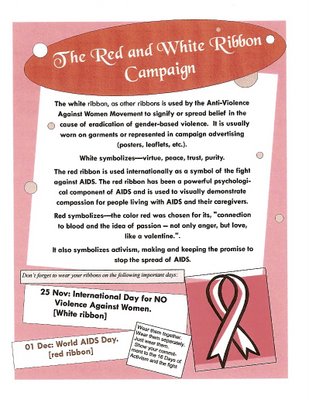 [Please click on the image to enlarge it and read about the Ribbon Campaign]
[Please click on the image to enlarge it and read about the Ribbon Campaign]
Sunday, October 29, 2006
Lessons We Learnt from this Project
“One of the lessons learnt was that society’s knowledge regarding the 16 Days of Activism and its content is extremely limited but by creating awareness via media advocacy (posters, articles and pamphlets as we have done) this could be easily combated. I learnt how to convey a large amount of relevant information in very simple, but effective ways.
We also learnt the power of the spoken word, the action and the value of symbols, which all culminated in assisting organizations that help abused or HIV positive women and children and which was represented by the red and white ribbons. Silence truly is violence, and in order to act against abuse, we need to speak out and share our stories as victims and survivors of abuse, in order to remove the stigma related to rape and AIDS and in order to help those who have undergone similar experiences.”
Hayden:
“I learned that a lot can be done if people worked together. Taking our group as a reference point, I saw how a few people could come together and with the right attitude and willingness to achieve a goal, can help a number of people improve their lives.
I saw the dedication of people in the group and the work that they produced, and if we could get all South Africans to work together the way that the group did, it would certainly go a long way towards eradicating abuse. It all boils down to commitment, enthusiasm, dedication, persistence and hard work.”
Jennashree:
“The greatest lesson that I had learnt throughout this project was the fact that women abuse is the greatest scourge that is devouring South Africa. It is the worst form of violation that any woman experiences and the process toward receiving help is just as traumatic. Many women are not aware of their rights and are of the belief that the justice system cannot do much for them.
Further it must be noted that while conducting research it was found that although equality is attempted to be realised – it actually has not. Society is still in transition to reaching this ideal. Women abuse stretches across race, class, culture, religion and is the one destroyer of all equality that has been achieved and fought for thus far…
In short, more needs to be done to educate women and children about their rights, and how to access and enforce these rights. Although we have attempted to do this, it was limited by the fact that we were conducting a campaign mainly targeted at students and lecturers at Howard College. We learned how to draw inspiration from each other as women, and how to take a man’s perspective into account in dealing with such sensitive topics as gender-violence, child abuse and HIV/AIDS.”
Leander:
“Regardless of the implementation of the South African Constitution that contains a Bill of Rights which promotes equality, human dignity and freedom, there are still numerous woman and children being subjected to abuse. This is due to the fact that most woman and children fear seeking help because society does not want to talk about violence against woman and children. Our group and many organisations have tried to draw awareness to violence against woman and children especially during the 16 days of activism however; it is up to society to continue promoting 16 days of activism not only during the 16 days but all year through. I’ve learnt that attention cannot only be paid to the issues of violence against women and AIDS on their respective International Days and during the 16 Days of Activism, but rather, in order for there to be significant, tangible change, it must be 365 Days of Activism.”
Vishanta:
“I learnt the following lessons:
To co-ordinate and co-operate;
Time management;
How to harness resources effectively and efficiently; and
How to exploit the strengths of others in a positive way.
I also learnt that we cannot rely on the private business sector to make contributions and assist us in raising funds or creating awareness, that if we want something done properly, we must do it ourselves.”
Tamaryn:
“The proverb ‘change is in your hands’ really hit home with this project. We were given the opportunity to contribute to towards the transformation of our society into one where gender equality and mutual respect can be a reality. I began to understand that we could do this by creating awareness, providing relief to those in need, and using our position as students, where we have access to a large number of educational resources and information technology as well as contact with a wide variety of people, in order to get our message across.
I also learnt that the only restrictions and limitations with a project like this are those that you place on yourself. In order to achieve what you have set out to do, it requires belief in yourself, belief in your peers and perseverance and as much confidence as you can manage. Practically, if you have a broad set of objectives I learnt to break it down into numerous smaller components and tasks, which can be undertaken and completed and which accumulate to form something, in this case, that outgrew even my high expectations.”
Manyano:
“I’ve learnt that while it is important to be able to work in a group and co-ordinate efforts, it is also important to have a so-called ‘Plan B’ and in some instances even a ‘Plan C’. When working with such a large group, and when having to place reliance on people outside the group, consider all eventualities and plan for all possible things that could go wrong. That way, when something does go wrong, instead of panicking, we can just calmly implement the back-up plan.
I’ve also learnt that in the face of such challenges, we discover aspects of ourselves that we did not know were possible, we learn to think laterally and to work our way around problems with what we have.”
Suhema:
“I’ve learnt the importance of staying focused. With such a broad topic it was easy to get carried away and focus on only one aspect, but by clearly stating our goals and objectives, and constantly referring back to them when we thought we were getting side-tracked, this helped to keep us in focus.
It also stimulated and encouraged us to work harder by having the Meeting Reports and by meeting and reporting back to the group and then reporting to our Project Supervisor. This combination proved an effective set of checks and balances to ensure that contributions were evenly made and that effort did not go unnoticed.”
Kerona:
“I learnt the lesson that while some inter-group competition (meaning, competition between groups) is healthy and motivates us to work harder, it is important not to get involved in inter-group politics, and not to get involved in other groups’ arguments, or listen to gossip. The most important thing to stay focused on is our project and to remain true to our beliefs and principles.
I also learnt that setbacks can be overcome, and that disappointments are to be expected, and that every challenge provides us with an opportunity to pull together as a team and work out a solution. The advantage of working in a group is that when one person becomes de-motivated because of a set back, there are others around to encourage that person, and to inspire them and the rest of the group”
Take this Quiz
 http://www.thebody.com/surveys/sexsurvey.html
http://www.thebody.com/surveys/sexsurvey.htmlThis quiz asks a series of questions and identifies behaviour that places you at risk of being exposed to the virus.
It offers advice on how to change this behaviour to reduce your chances of exposure.
It is completely anonymous and is being used for research purposes, so take 2 mins of your time and fill it out!!
Saturday, October 28, 2006
Challenges and Successes
The group identified the following as being challenges in devising and implementing our assignment, and formulated the following strategies to overcome them -
1. Defining our focus and limiting our ideas –
It was difficult for us to define exactly what we wished to achieve and the methods whereby we would do this. This difficulty was encountered as a result of the broad nature of the topic, and the variety of ideas presented by the group. We had to limit ourselves in line with financial and time constraints. Although we managed to raise a substantial amount of money, we then had to decide how to utilize it in a way that would achieve our objectives as cost-effectively and efficiently as possible.
We thus chose to use it to do the following –
- Purchase food, toiletries and other items needed by a number of organizations that assist abused women and children;
- Implement our awareness campaign by buying or making the following –
Posters, flyers, leaflets;
- Badges, T shirts;
- Our Awareness and Advocacy Packages;
- A 16 Days of Activism Mural (situated outside Student’s Union Building)
- Putting together and finalizing our written and oral presentation and all the materials needed in that respect.
2. Co-ordination and working in a large group -
This proved to be very taxing, as having members from both groups in our year meant that there were many timetable clashes, and not all members were free at the same time. It was difficult to meet up and delegate work and supervise progress of work.
To combat this challenge we drew up Meeting Schedules and Progress Reportswhich dealt with the following –
- Each person’s individual tasks for the week, and progress made and steps to still be taken.
- All other member’s tasks, current progress and further steps to be taken. This was to ensure that everyone in the group knew what all the other members were doing and could check up on each other’s progress and offer assistance where needed.
- A record of items discussed at meetings, so that we could draw further ideas and inspirations and keep a record of the development of our Campaign Plan and our objectives;
- A register of attendance, so that we could keep track of and identify those individuals that needed to be encouraged to work harder, in order to prevent anyone from being inactive and to avoid conflicts over the amount of work being done by individuals. The register also served to identify those persons who made a contribution over and above what was expected. A register also compelled members to attend meetings, failing which they had to excuse themselves beforehand and apologise to the group. It also stated the time, date and place of future meetings – so there could be no confusion in that respect and to avoid wasting time searching for venues and group members.
3. Encouraging people on campus to contribute to our campaign -
At first, we thought to put out posters and email all students and staff with a list of requirements, informing them that they could drop them off at Collection Points around campus, but this proved to be ineffective, although people noticed our posters, emailed in asking where they could drop stuff off, but then the following happened –
- Boxes were stolen or thrown away at the collection points;
- People weren’t interested in making a contribution, or it was too much of a hassle to bring bags of clothing or canned food in to campus to drop off;
- Students at the Westville campus Law Clinic used our posters and our publicity from the emails, collected our contributions and then used them for their own purposes. We had confirmation that they used our posters from Professor Vawda, who remarked that he had seen our poster on Westville campus while lecturing there.
So we dealt with the above-mentioned setbacks by raising funds ourselves in order to purchase what we had hoped students would contribute. We raised these funds in the following ways –
- Soliciting contributions from the lecturers on Campus.This proved to be very effective, and we raised a large portion of our funds in this way;
- Having a cake sale. Although we were at first opposed to this idea, it was relatively easy to organize, execute and raised a fair amount of money.
- Selling our Red and White Ribbons. This raised about a quarter of our total sum, and served a two-fold purpose. Firstly, raising funds, and secondly promoting awareness of our cause and about the 16 Days of Activism in general.
- An intra-group donation scheme was set up, whereby we each contributed money, materials or time and skills as we were each able to. This also proved to be very profitable, and showed our group’s willingness to reach into their own pockets for our cause.
- Emailing various companies, corporations and organizations requesting donations and contributions, and although we received many refusal e-mails in return we did manage to receive a donation from Pick ‘n Pay. Although Lil-Lets was willing to donate a number of sanitary products, it proved too difficult to organize the delivery in time for our presentation.
- Our personal contacts were utilised to their full extent, in this respect we achieved the following –
- Tamaryn made use of her contact, Phil Botha of Flatline Productions, to paint a mural on campus publicizing the 16 Days of Activism, and outlining the important dates;
- Fiona’s father owns a wholesale store, from which we received a number of generous donations;
- Terrence and Sarah of Delta Communications sponsored all our printing, copying and stationery requirements for the awareness portion of our campaign, and also the costs of printing and binding our written presentation and various other materials;
- Tony Miller of Tony Miller Promotions produced our Campaign badges for us at a discounted price; and assisted us in organizing our campaign T shirts.
We thus suprised ourselves by turning our challenges into successes.
Friday, October 27, 2006
Thursday, October 26, 2006
Sunday, October 22, 2006
Speak Out
 In line with the theme of 'speaking out' we'd like to know your answers to any of the following: (your responses can be anonymous if you wish)
In line with the theme of 'speaking out' we'd like to know your answers to any of the following: (your responses can be anonymous if you wish)



